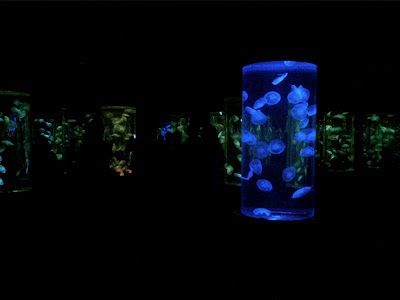graceful sea jellies
One of my first encounters with jellyfish, or sea jellies (as scientists call them now), was when I was eight years old. I, along with the siblings and some friends scooped out a jellyfish from the sea (back then, all of us didn't know the dangers of doing so) and placed it in a transparent glass powdered coffee bottle filled with water. Since the water came from the tap, we added salt into the water, iodized salt.
Poor jellyfish.
I've since gone to visit a few aquaria during trips overseas. So when the Manila Ocean Park opened a few years back, I wanted to go there to see how it compares to the other ones I've seen. The first chance I got to really explore the place was on June 19th, when I went with Ate Bing and Ate Mary.
One of the attractions we visited was the "Jellies: Dancing Sea Fairies". It turned out to be one of my favorites. Just inside the room, we were greeted by the life cycle of a sea jelly... in glow-in-the-dark. The room was bathed in darkness, probably to make it easier for use to see the jellyfish. The persons who built this enclosure was successful: not only did our attention concentrate on these sea creatures, but I noticed the music a lot more because there were very few things to make me distracted.
Different species of sea jellies were in several aquariums with black backgrounds. As the lights changed in time with the music, the colors on the jellyfish changed too. I was fascinated with how graceful these jellyfish were. They floated up and down their aquaria, mindless of the people taking photos, tapping on the glass, and ooh-ing and aah-ing.
One important thing to remember about these jellyfish: while they are pretty to look at not all of them are safe. For example, big groups of jellyfish could disrupt power plant operations and tentacles of some species could actually inflict excruciating pain to the unfortunate sea swimmer. That's the kind of danger I had never thought about back on the beach as the "pet" jellyfish was transferred from sea to iodized salt water.
At the very end of the exhibit was one of the more dramatic displays of moon jellies. I felt like I was walking in one of Batman's secret rooms... except that instead of suits of armor, there were several cylinders of floating multicolored jellyfish. Quite haunting, really.




Comments
Post a Comment
Thank you for dropping by!
Before moving on, please share your thoughts or comments about the post. :)
Thanks again!